Wilshire Boulevard, a Main Street that stands apart
Los Angeles has long tested out its grandest ambitions on Wilshire Boulevard, where innovation has arisen even as dreams have been dashed.
Click the blue mile markers above — or use the arrows — to take Christopher Hawthorne's guided tour of key sites along Wilshire Boulevard.
March 23, 2013
We think of Wilshire Boulevard as synonymous with Los Angeles — as our Main Street.
But Wilshire has always stood apart from the city it slices through. It is denser and more urbane, its architecture more vertical.
No, rather than act as a perfect symbol of Los Angeles, Wilshire has operated as a proving ground for new ideas about architecture, commerce, transportation and urbanism in Southern California. For nearly a century Wilshire has been L.A.'s boulevard of prototypes, a string of hypotheses 16 miles long.
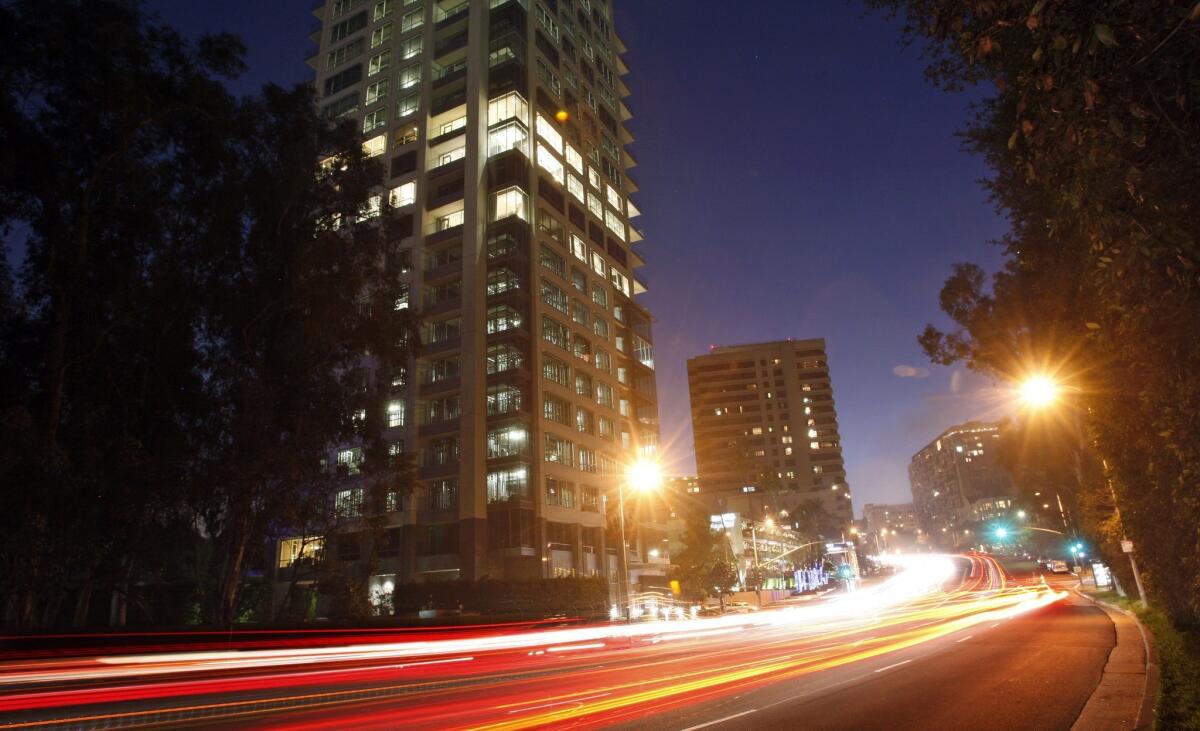
Traffic streams along Wilshire Boulevard as the verdant expanse of the Los Angeles Country Club gives way to the high-rise residential buildings of Westwood. (Luis Sinco / Los Angeles Times) More photos
It's where we first tried a linear downtown, stretching west toward the ocean, instead of a traditional, consolidated one at the foot of City Hall. It's where L.A. built its first synchronized traffic lights, Art Deco landmarks and clusters of high-end apartment towers.
Most of the major boulevards The Times has examined in this series over the past year had faded in prominence in the post-war, freeway-building era, only to find new momentum more recently. Wilshire, though, never lost its reputation as the place where Los Angeles embraced and tested out the future.
But if Wilshire has been the prow of L.A.'s ship, there have been quite a few icebergs along the way. The street's history is full of dreams dashed in high-profile fashion. It's where plans for a subway to the sea and the tallest building in the world — among many other big-ticket projects — have risen and stalled.
Wilshire is our boulevard of cold feet and second thoughts, the place where Los Angeles confronts its deep ambivalence about putting a low-rise, car-dominated and essentially suburban past behind it for good.
The result on today's Wilshire is a lurching, piecemeal utopianism that can take you from a world-famous piece of architecture to a weed-choked lot, from a realized ambition to an abandoned one, in the space of a few blocks.
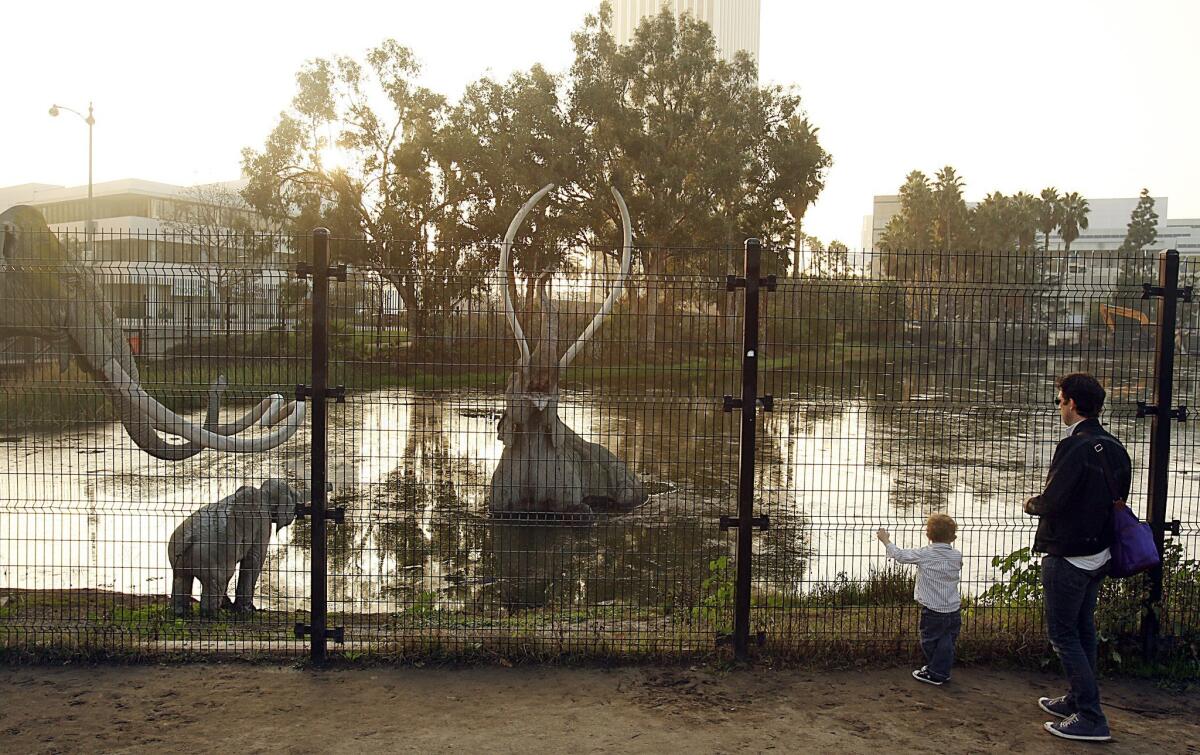
The La Brea Tar Pits sit bubbling along Wilshire, a reminder of the boulevard's primordial significance to Los Angeles. (Luis Sinco / Los Angeles Times) More photos
Some of Wilshire's fundamental contradictions can be traced back to the man who gave the boulevard its name. H. Gaylord Wilshire was an entrepreneur and a socialist; he was a publisher, a frequent candidate for public office, a friend to George Bernard Shaw and a promoter of quackish health products.
"I have no doubt that when we have Socialism … Southern California will be the most thickly settled part of the American continent," Wilshire wrote.
That deeply optimistic if politically inconsistent notion was Gaylord Wilshire in a nutshell. Socialism, he believed, would pack Los Angeles with new arrivals — and therefore be exceptionally good for business.
In 1895 Wilshire, with his brother and father, bought a triangle-shaped parcel of land just west of downtown. Shortly after he filed a plan for a new subdivision on the site, with a road he called Wilshire Boulevard running east-west across the middle.
The growth of the boulevard from that modest start was more happenstance than grand plan. To the west, Wilshire was eventually linked with Nevada Avenue in Santa Monica. In 1934, Wilshire was extended east and connected to downtown with a causeway across MacArthur Park.

Wilshire Boulevard runs between the two halves of MacArthur Park. Originally named Westlake Park, the site was built in the 1880s around wetlands fed by natural springs. (Luis Sinco / Los Angeles Times) More photos
Wilshire Boulevard is the product of a dream that nobody ever dreamed, not even Gaylord Wilshire himself. It's a world-famous street that came together in fragments.
This fissure between ambition and reality is at the heart of the street's character. There are moments when you are walking or driving down it — in the thicket of apartment towers in Westwood known as Condo Canyon, say — when it seems fully and comfortably urban.
But there are others when its diverse, inchoate nature is plainer to see; there's no other street in Los Angeles that shows so many faces to the public. The low-rise section of Wilshire cutting through Santa Monica has an entirely different feel than the stretch that runs alongside the fairways of Los Angeles Country Club, to say nothing of the downtown skyscrapers marking its eastern end.
Wilshire also lacks many outward signs of car culture. As the boulevard has grown denser, and real estate along it more expensive, automotive businesses have simply been priced out. You can go several miles without seeing any of the gas stations, auto-body shops and drive-ins that were so central to Wilshire's identity in the first half of the 20th century and remain such a fixture on L.A.'s other major streets.
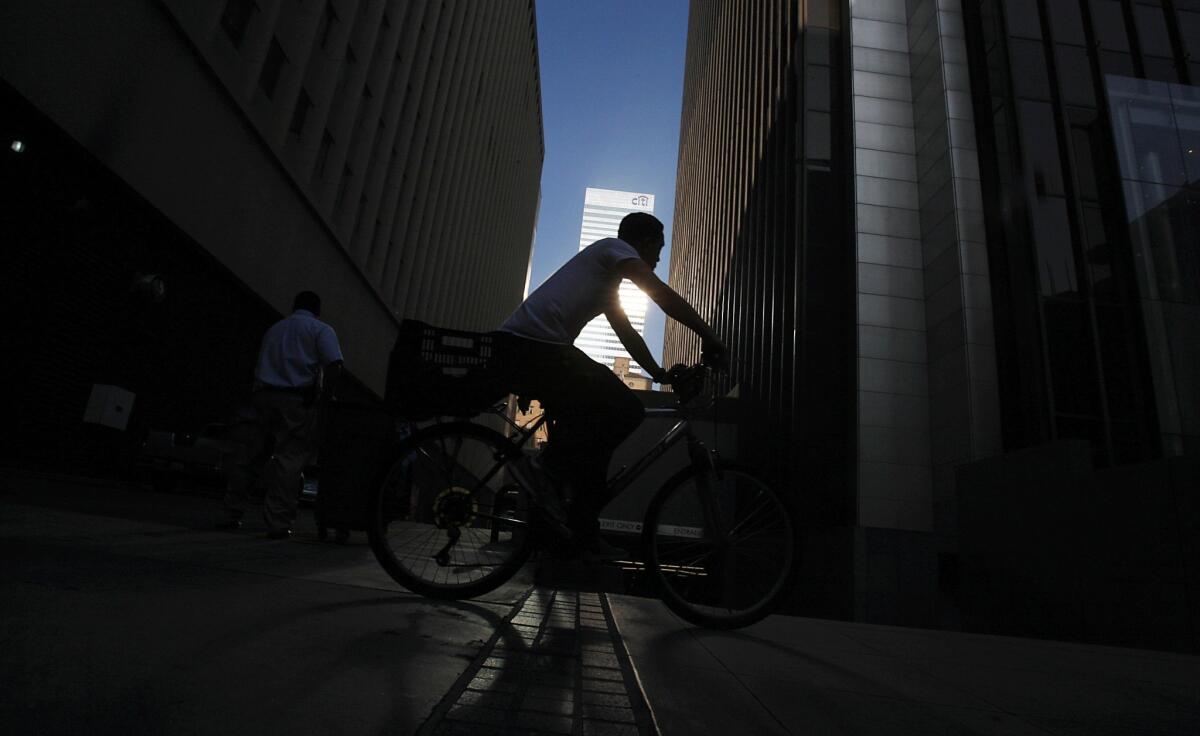
A bicyclist rides amid the shadows of tall buildings along Wilshire, in one of the stretches lined by dense development. (Luis Sinco / Los Angeles Times) More photos
Now, Wilshire is stuck in a kind of limbo. The car culture on Wilshire has faded, but a comprehensive rail system and renewed sense of pedestrian culture have yet to take root.
For many of those who live or work on Wilshire, that limbo defines their commutes. Ron Galarze, who works in the epicure department at Neiman Marcus in Beverly Hills, strode out of a Subway sandwich shop across from the store on a recent afternoon wearing a thrift-shop tuxedo, perfectly polished black dress shoes and glasses with chunky frames. He takes the bus to the store from his home in Whittier, a trip that takes between 90 minutes and 2 1/2 hours each way.
"I ride in with a lot of the dishwashers and the clerks that do the behind-the-scenes kind of work for these stores," he said.
More than a few of the boulevard's still-disconnected fragments, however, were the products of visionary thinking. First Gaylord Wilshire imagined that his land west of downtown could be a stylish new residential district, an idea fulfilled when Gen. Harrison Otis, the longtime Los Angeles Times owner and publisher, and then his rival in the newspaper business, Edwin T. Earl, built side-by-side mansions in the late 1890s.
By the 1920s businesses trapped in an increasingly congested downtown began seeing Wilshire's potential as an alternative retail district. Bullock's department store hired architects John and Donald Parkinson, who also designed L.A.'s City Hall, to produce a beacon for commerce along Wilshire that opened in 1929.
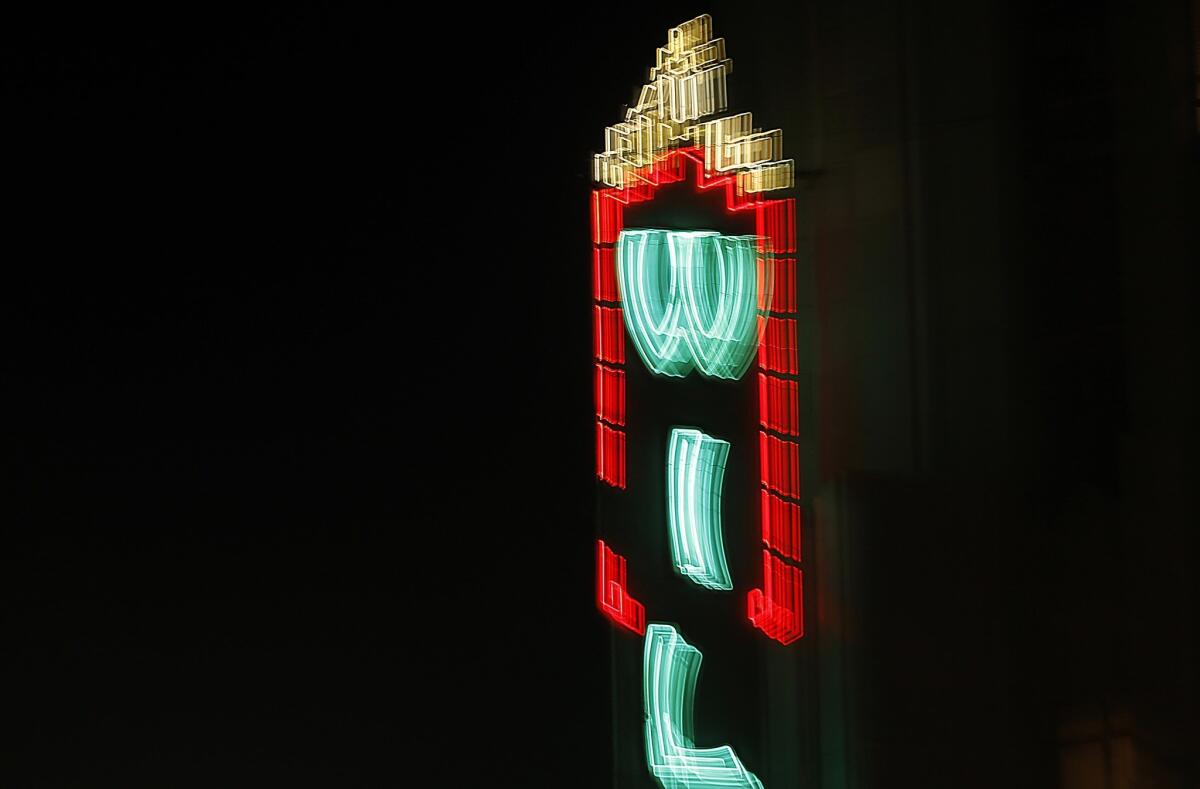
The neon marquee of the Wiltern, a landmark Art Deco theater, glows over the intersection of Wilshire Boulevard and Western Avenue. (Luis Sinco / Los Angeles Times) More photos
The store pioneered a number of car-centric features that would become common all over Los Angeles, including an entrance facing the parking lot that was as grand as the one along the sidewalk. Developer A.W. Ross used many of the same strategies as he pursued a daring plan in the 1920s to remake the stretch of Wilshire between La Brea and Fairfax avenues as the Miracle Mile.
But for every audacious project, there were several more that never panned out. Among the most memorable was a proposal for a series of ceremonial triumphal arches patterned after those in Rome but named for heroes from California's own history: Cabrillo, Fremont and Balboa, among others.
More recently, a proposal to build a rapid-bus route along the length of Wilshire foundered when Beverly Hills, Westwood and Santa Monica decided they didn't want to give up a lane of traffic.
Those failures are emblematic of Wilshire's fortunes over the years. As a site for stand-alone feats of innovation or architectural significance — Myron Hunt's original Ambassador Hotel, Welton Becket's House of Tomorrow — the boulevard has been unusually fertile ground.
But efforts to reimagine or stitch together the whole boulevard, which would require the approval of different cities and their dozens of elected officials, have always been nearly impossible to execute.
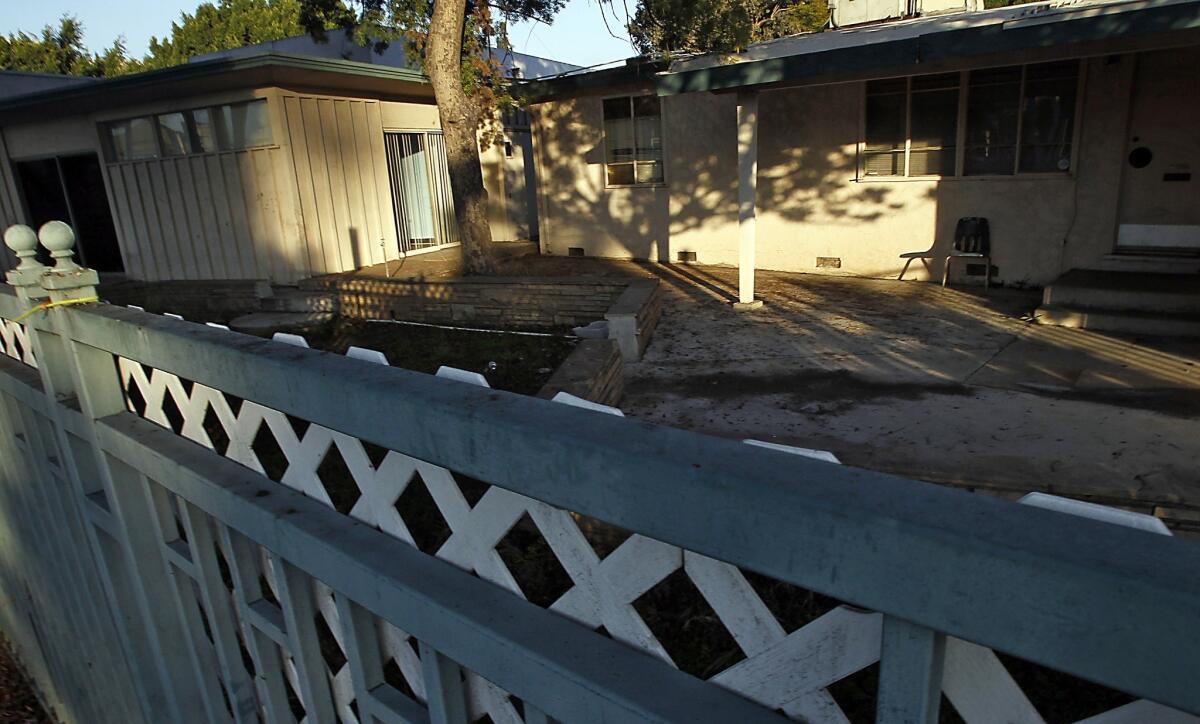
The 1946 Post-War House, also known as the House of Tomorrow, sits largely ignored and in decay at 4950 Wilshire Blvd. -- a forgotten relic of a more optimistic time. (Luis Sinco / Los Angeles Times) More photos
No civic project better illustrates Wilshire's ambitious and uneven history than the idea of the subway along its length. (Debates over the future of the Ambassador Hotel site, where Donald Trump once planned to build the world's tallest tower, are a close second.) First imagined in the 1920s, the Wilshire subway was partially built 25 years ago, from downtown to Western Avenue.
If completed all the way to the beach at that point, it would have been a revolutionary demonstration of L.A.'s new commitment to public transit. But its progress was halted by a powerful and well-funded opposition based largely on the Westside.
Now it's been revived and renamed the Purple Line. Despite the best efforts of the Beverly Hills school board, which continues to oppose a subway tunnel beneath the city's high school, it seems finally on track for completion.
As the Wilshire line faced delay after delay, the rest of the city was quietly building an expansive bus and rail network that has revivified the city's boulevards. The growth of that network, and the rise of bike culture that has accompanied it, has blunted some of the importance of the Purple Line as a transit innovation.
Still the subway, as the capstone of L.A.'s transit revolution of the last three decades, promises to act as a powerful catalyst. More than anything, it will intensify Wilshire's traditional role as L.A.'s boulevard of reinvention.

At the densely packed intersection of Wilshire Boulevard and Vermont Avenue stands the Metro Red Line Station. (Luis Sinco / Los Angeles Times) More photos
When the subway reaches Westwood two decades from now, it won't just bring the UCLA campus close to the Metro rail grid for the first time. It may give the university the impetus to step out from its leafy and essentially suburban campus and try out a high-rise architectural personality.
UCLA owns a 7-acre piece of land, known as Lot 36, at the northwest corner of Wilshire and Gayley Avenue in Westwood. If you visit it today you'll find a nondescript collection of parking lots and low-rise buildings.
But the Metropolitan Transportation Authority has announced plans to build a Purple Line station under Lot 36. Because UCLA isn't subject to local zoning or height limits, it could build atop the subway stop a very tall tower holding classrooms, apartments and even a museum or auditorium.
"We have a temporary building there now, but we do see this as a key site for UCLA in the future," Jeffrey Averill, UCLA's campus architect, said in an email. So do other architects, who look at the chance to design a tower on Lot 36 as the commission of a lifetime.
An architecturally bold skyscraper on the site "would dramatically change the image of the university," said Neil Denari, an architect and UCLA professor who has produced a preliminary study for a cluster of connected towers at Lot 36. "It could be a kind of instant conversion to urbanism" for a school that until now "has been a drive-in, drive-out world."
The subway is also poised to transform the Los Angeles County Museum of Art. LACMA's leaders have sometimes fretted that it was marooned on its campus on the western edge of the Miracle Mile, removed from the freeway grid and therefore difficult to reach, at least in the minds of many Angelenos.
When the Getty Center opened on a Brentwood hilltop in 1997, inside a luxe billion-dollar campus by the architect Richard Meier, LACMA seemed to be falling even further behind in the chase for attendance. The Getty was right next to the 405 Freeway, after all, near the epicenter of Westside wealth.

The Los Angeles County Museum of Art's campus on Wilshire has been considered hard to get to by car, but it will be more central when the Purple Line subway is built in about 10 years. (Luis Sinco / Los Angeles Times) More photos
Fast-forward 16 years and the conventional wisdom has dramatically changed. As became clear during the two recent Carmageddon shutdowns of the 405, when the museum was forced to close, the Getty's reliance on the freeway system has become a liability. LACMA, on the other hand, will enjoy a new centrality once the Purple Line reaches Wilshire and Fairfax 10 years from now. It will likely get another boost in attendance when the subway is extended west to Rodeo Drive by 2025 or so.
Under director Michael Govan, the museum is redesigning the eastern half of its campus with the Swiss architect Peter Zumthor. It has purchased a piece of land on the south side of Wilshire, to go with a parking lot it already owns, and may build offices or gallery space above a Metro subway station. "The sense of arrival is so key at any museum," Govan said. If a subway entry is built on the south side of Wilshire, "you'll see the whole campus in front of you, this sweep of new and old architecture."
The plan that Govan is developing with Zumthor, like the museum's larger preparations for the arrival of the Purple Line, is in its early stages. There are many ways it could go awry, from architectural missteps to fundraising ones.
But in its ambition and scope it is a classic Wilshire maneuver, with yet another major L.A. institution looking to a piece of real estate along the boulevard for a chance to remake itself.
Explore: Atlantic Boulevard, Crenshaw, Lankershim and Sunset Boulevard with Christopher Hawthorne Los Angeles Times Architecture Critic.
Graphic credits: Paul Duginski and Lorena Iñiguez Elebee | Graphics reporting: Brady MacDonald | Programming: Anthony Pesce | Produced by: Lily Mihalik
Sources: ESRI, TeleAtlas



